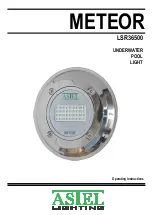
1.
Do not use undissolved and/or granulated chlorine or
chlorine tablets in an ionized pool. It may have the
effect of forming a crust effect on the surface of the
anodes and reducing the anodes life and reducing Ion
output.
2.
When replacing the mineral anodes
, ensure that they
are free of water. Ensure also that the O-Rings are in
place inside the Barrel Union fittings before screwing
the Barrel Union nuts into place.
3.
Keep test kits in a cool place
(not the Fridge) in hot
weather/hot climates. Store out of direct sunlight.
4.
The use of a pool cover is recommended
as it saves
time and effort in keeping debris out of the pool whilst
the pool is not being used. It can save 30,000 litres or
more of water loss (evaporation) per year on the
average size pool.
Note:
www.discountpoolcovers.com.au
for great quality
and prices on pool blankets and rollers.
5.
Take a few minutes each week to thoroughly brush
the walls, steps and floor
of the pool and clean the
skimmer box and remove leaves and debris from the pool.
This small chore will repay you repeatedly by ensuring a
sparkling clean swimming environment at all times.
6.
A t c e r t a i n s e a s o n a l t i m e s o f t h e y e a r
(spring/summer) the pool may tinge green or
develop green residue
on the bottom. This can be
mistaken for algae but is often
pollen
. The easy test is:
run your hand around inside the wall of skimmer box
or pool surface under the waterline. If it is slippery or
slimy it is likely to be algae. If not, then it is most likely
pollen. If it is pollen, use polymer clarifier such as
Bionizer Blue, Bioguard Polysheen Plus. Do not use a
clarifier or flocculent that removes metal ions from the
water.
7.
Using chlorine to try and kill "algae" (really pollen)
will only bleach the pollen so it disappears.
It is likely
to reappear in your pool days later. If you continually
mistake this for algae and continue the chlorine cycle
until the pollen season is finished you will suffer the
effects of too much chlorine and your pool will be out
of control.
8.
To rectify this problem use a flocculant
that does not
remove minerals or metals from the water – e.g.
“
Bionizer Blue
”. This process may have to be
repeated several times if the pollen is still in the
environment and there are trees and shrubs
surrounding your pool.
9.
We strongly recommend the use of an automatic
pool cleaner
once a week or so in the pool. This will
save a lot of time and effort and also keep the pool
clean and free of any algae causing contaminants.
10. Do not operate the auto pool cleaner or any water
features during the ionizing/start-up phase as they
slow the water flow considerably. The pools that
operate best always have very good water circulation
so limit the auto pool cleaning times if possible.
11.
We recommend using "Glass" Filter Medium in your
filter.
This medium is superior to other mediums such
as river sand or zeolite in our opinion. River sand is not
a quality medium and is not recommended. Make sure
all old sand/medium is removed completely before
replacing it with the new medium in an existing filter.
This is important!
12.
If you have a heated pool
(this especially applies to
indoor pools) that uses a pool blanket when the pool is
not in use it is recommended that you maintain a
residual Oxidizer level (hydrogen peroxide/chlorine) at
minimum 0.5ppm in the water. This is to prevent any
harmless environmental bacteria from hiding beneath
the pool blanket thus causing a "smelly sock" type of
odour.
We recommend the Bionizer Eco-Oxidizer to
take care of this.
13. If you are not a diligent pool owner, or if you are
planning on going on an extended holiday, use the
Bioniser
product to ensure that your pool
will be sparkling clear when you return. You may use a
double dose of
if you will be away for more
than 2 weeks.
TIPS FOR TROUBLE-FREE SWIMMING
25












































